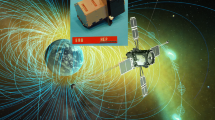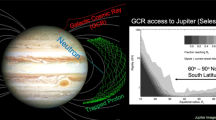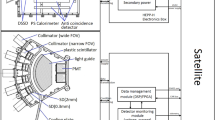Abstract
The Planck High Frequency Instrument (HFI) has been surveying the sky continuously from the second Lagrangian point (L2) between August 2009 and January 2012. It operates with 52 high impedance bolometers cooled at 100 mK in a range of frequency between 100 GHz and 1 THz with unprecedented sensitivity, but strong coupling with cosmic radiation. At L2, the particle flux is about 5 \(\hbox {cm}^{-2}\,\hbox {s}^{-1}\) and is dominated by protons incident on the spacecraft. Protons with an energy above 40 MeV can penetrate the focal plane unit box causing two different effects: glitches in the raw data from direct interaction of cosmic rays with detectors (producing a data loss of about 15 % at the end of the mission) and thermal drifts in the bolometer plate at 100 mK adding non-Gaussian noise at frequencies below 0.1 Hz. The HFI consortium has made strong efforts in order to correct for this effect on the time ordered data and final Planck maps. This work intends to give a view of the physical explanation of the glitches observed in the HFI instrument in-flight. To reach this goal, we performed several ground-based experiments using protons and \(\alpha \) particles to test the impact of particles on the HFI spare bolometers with a better control of the environmental conditions with respect to the in-flight data. We have shown that the dominant part of glitches observed in the data comes from the impact of cosmic rays in the silicon die frame supporting the micro-machined bolometric detectors propagating energy mainly by ballistic phonons and by thermal diffusion. The implications of these results for future satellite missions will be discussed.







Similar content being viewed by others
Notes
A glitch is the transient effect on the bolometer time ordered data associated with a cosmic ray impact somewhere in the detector system.
References
Planck Collaboration, A&A (2013, submitted). arXiv:1303.5062
Planck HFI Core Team, A&A 536, A4 (2011)
R.A. Mewaldt, A.J. Davis, K.A. Lave, R.A. Leske, E.C. Stone, M.E. Wiedenbeck, W.R. Binns, E.R. Christian, A.C. Cummings, G.A. de Nolfo, M.H. Israel, A.W. Labrador, T.T. von Rosenvinge, Astrophys. J. 723, L1–L6 (2010)
R.A. Leske, A.C. Cummings, R.A. Mewaldt, E.C. Stone, Space Sci. Rev. 176(1–4), 253–263 (2013)
W.A. Holmes, J.J. Bock, B.P. Crill, T.C. Koch, W.C. Jones, A.E. Lange, C.G. Paine, Appl. Opt. 47, 5996 (2008)
A. Mohammadzadeh, H. Evans, P. Nieminen, E. Daly, P. Vuilleumier, P. Buhler, C. Eggel, W. Hajdas, N. Schlumpf, A. Zehnder, J. Schneider, R. Fear, Nucl. Sci. IEEE 50, 2272–2277 (2003)
Planck Collaboration, A&A 536, A2 (2011)
A. Caserta, P. de Bernardis, S. Masi, M. Mattioli, Nucl. Instrum. Methods Phys. Res. A 294(1), 328–334 (1990)
Planck Collaboration, Results X. A&A (2013). arXiv:1303.5071
O. Adriani, G.C. Barbarino, G.A. Bazilevskaya, R. Bellotti, M. Boezio, E.A. Bogomolov, L. Bonechi, M. Bongi, V. Bonvicini, S. Borisov, S. Bottai, A. Bruno, F. Cafagna, D. Campana, R. Carbone, P. Carlson, M. Casolino, G. Castellini, L. Consiglio, M.P. De Pascale, C. De Santis, N. De Simone, V. Di Felice, A.M. Galper, W. Gillard, L. Grishantseva, G. Jerse, A.V. Karelin, S.V. Koldashov, S.Y. Krutkov, A.N. Kvashnin, A. Leonov, V. Malakhov, V. Malvezzi, L. Marcelli, A.G. Mayorov, W. Menn, V.V. Mikhailov, E. Mocchiutti, A. Monaco, N. Mori, N. Nikonov, G. Osteria, F. Palma, P. Papini, M. Pearce, P. Picozza, C. Pizzolotto, M. Ricci, S.B. Ricciarini, L. Rossetto, R. Sarkar, M. Simon, R. Sparvoli, P. Spillantini, Y.I. Stozhkov, A. Vacchi, E. Vannuccini, G. Vasilyev, S.A. Voronov, Y.T. Yurkin, J. Wu, G. Zampa, N. Zampa, V.G. Zverev, Science 332, 69 (2011)
S. Masi, E.S. Battistelli, P. de Bernardis, L. Lamagna, F. Nati, L. Nati, P. Natoli, G. Polenta, A. Schillaci, A&A 519, id. A24, 9 p. (2010)
Author information
Authors and Affiliations
Corresponding author
Rights and permissions
About this article
Cite this article
Catalano, A., Ade, P., Atik, Y. et al. Characterization and Physical Explanation of Energetic Particles on Planck HFI Instrument. J Low Temp Phys 176, 773–786 (2014). https://doi.org/10.1007/s10909-014-1116-6
Received:
Accepted:
Published:
Issue Date:
DOI: https://doi.org/10.1007/s10909-014-1116-6




